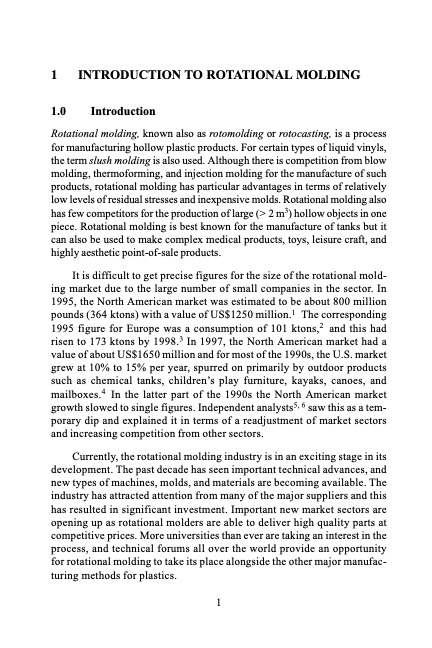
PDF Publication Title:
Text from PDF Page: 001
1 INTRODUCTION TO ROTATIONAL MOLDING 1.0 Introduction Rotational molding, known also as rotomolding or rotocasting, is a process for manufacturing hollow plastic products. For certain types of liquid vinyls, the term slush molding is also used. Although there is competition from blow molding, thermoforming, and injection molding for the manufacture of such products, rotational molding has particular advantages in terms of relatively low levels of residual stresses and inexpensive molds. Rotational molding also has few competitors for the production of large (> 2 m3) hollow objects in one piece. Rotational molding is best known for the manufacture of tanks but it can also be used to make complex medical products, toys, leisure craft, and highly aesthetic point-of-sale products. It is difficult to get precise figures for the size of the rotational mold- ing market due to the large number of small companies in the sector. In 1995, the North American market was estimated to be about 800 million pounds (364 ktons) with a value of US$1250 million.1 The corresponding 1995 figure for Europe was a consumption of 101 ktons,2 and this had risen to 173 ktons by 1998.3 In 1997, the North American market had a value of about US$1650 million and for most of the 1990s, the U.S. market grew at 10% to 15% per year, spurred on primarily by outdoor products such as chemical tanks, childrenís play furniture, kayaks, canoes, and mailboxes.4 In the latter part of the 1990s the North American market growth slowed to single figures. Independent analysts5, 6 saw this as a tem- porary dip and explained it in terms of a readjustment of market sectors and increasing competition from other sectors. Currently, the rotational molding industry is in an exciting stage in its development. The past decade has seen important technical advances, and new types of machines, molds, and materials are becoming available. The industry has attracted attention from many of the major suppliers and this has resulted in significant investment. Important new market sectors are opening up as rotational molders are able to deliver high quality parts at competitive prices. More universities than ever are taking an interest in the process, and technical forums all over the world provide an opportunity for rotational molding to take its place alongside the other major manufac- turing methods for plastics. 1PDF Image | INTRODUCTION TO ROTATIONAL MOLDING 1

PDF Search Title:
INTRODUCTION TO ROTATIONAL MOLDING 1Original File Name Searched:
Introduction-To-Rotational-Moulding.pdfDIY PDF Search: Google It | Yahoo | Bing
Development of a solar powered Electric Ship The Electricship website originally started off as a project to develop a comprehensive renewable, affordable, modular electric ship... More Info
Modular Boat Hull Composite The case for a unsinkable, modular composite hybrid boat hull... More Info
MS Burgenstock Hybrid Electric Catamaran Lake Lucerne Unique shuttle servicing Lucerne to the Burgenstock Resort... More Info
Ground Power Unit GPU Powered by Lithium Ion Batteries The goal of the Ground Power Unit is to provide a readily accessible, modular, ready-to-power solution for remote power... More Info
| CONTACT TEL: 608-238-6001 Email: greg@electricship.com | RSS | AMP |